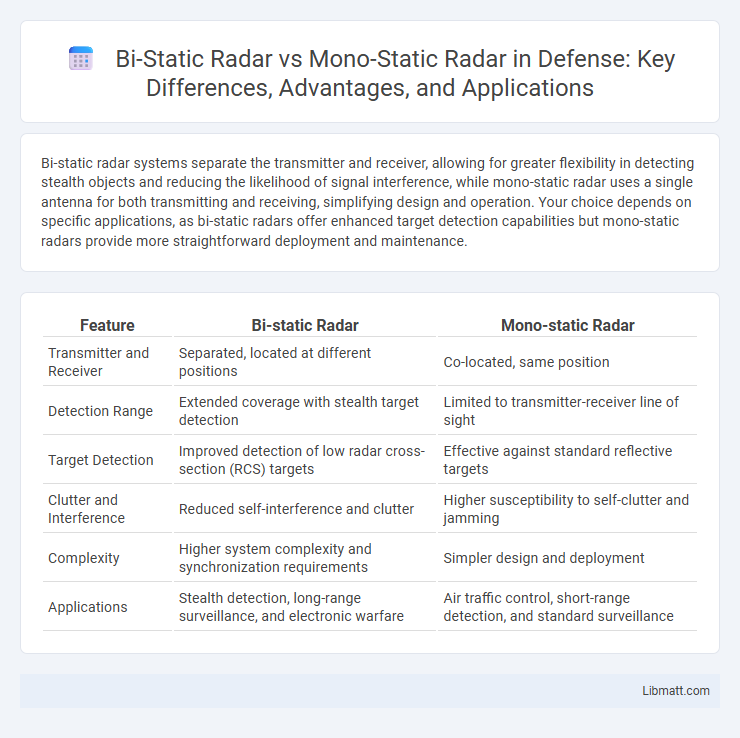Bi-static radar systems separate the transmitter and receiver, allowing for greater flexibility in detecting stealth objects and reducing the likelihood of signal interference, while mono-static radar uses a single antenna for both transmitting and receiving, simplifying design and operation. Your choice depends on specific applications, as bi-static radars offer enhanced target detection capabilities but mono-static radars provide more straightforward deployment and maintenance.
Table of Comparison
| Feature | Bi-static Radar | Mono-static Radar |
|---|---|---|
| Transmitter and Receiver | Separated, located at different positions | Co-located, same position |
| Detection Range | Extended coverage with stealth target detection | Limited to transmitter-receiver line of sight |
| Target Detection | Improved detection of low radar cross-section (RCS) targets | Effective against standard reflective targets |
| Clutter and Interference | Reduced self-interference and clutter | Higher susceptibility to self-clutter and jamming |
| Complexity | Higher system complexity and synchronization requirements | Simpler design and deployment |
| Applications | Stealth detection, long-range surveillance, and electronic warfare | Air traffic control, short-range detection, and standard surveillance |
Introduction to Radar Systems
Radar systems utilize radio waves to detect objects and determine their position, velocity, and other characteristics. Mono-static radar features a single location for both the transmitter and receiver, simplifying alignment but potentially limiting detection capabilities due to signal interference. Bi-static radar separates the transmitter and receiver spatially, enhancing stealth detection and reducing the vulnerability to electronic countermeasures by exploiting different geometric perspectives.
Understanding Mono-static Radar
Mono-static radar systems operate with the transmitter and receiver co-located, enabling the radar to transmit pulses and receive echoes from the same position. This configuration simplifies signal processing and target detection by minimizing spatial ambiguity and allowing precise measurement of range, Doppler shift, and angle of arrival. Mono-static radars are widely used in applications such as air traffic control, weather monitoring, and military targeting due to their compact design and effective detection capabilities.
Exploring Bi-static Radar
Bi-static radar systems use separate locations for the transmitter and receiver, enhancing detection capabilities by exploiting spatial diversity and reducing vulnerability to electronic countermeasures. These systems provide improved target classification and stealth detection by analyzing differences in signal reflection angles and time delays. Compared to mono-static radar, bi-static radar offers increased resilience in cluttered environments and better performance against low-observable targets.
Key Differences Between Mono-static and Bi-static Radar
Mono-static radar systems use a single antenna for both transmitting and receiving signals, resulting in simpler design and direct target detection, while bi-static radar employs separate locations for the transmitter and receiver, enhancing stealth and resistance to electronic countermeasures. The geometric configuration in bi-static radar creates diverse detection angles, improving target resolution and reducing vulnerability to jamming compared to the co-located setup in mono-static radar. Understanding these key differences helps optimize your radar system choice for specific surveillance and defense applications.
Advantages of Mono-static Radar
Mono-static radar systems offer the advantage of simplified design by using a single antenna for both transmitting and receiving signals, reducing hardware complexity and cost. They provide better target detection accuracy due to precise timing control and minimal signal path loss, enhancing the signal-to-noise ratio. Additionally, mono-static radars facilitate easier installation and maintenance compared to bi-static radar setups, which require spatially separated components.
Benefits of Bi-static Radar
Bi-static radars offer enhanced detection capabilities by separating the transmitter and receiver, reducing vulnerability to electronic countermeasures and enabling improved target localization through diverse viewing angles. Their spatial separation allows for lower probability of intercept, making them ideal for stealth operations and covert surveillance. Your surveillance system benefits from increased resilience and accuracy when leveraging bi-static radar configurations over traditional mono-static designs.
Limitations of Mono-static Radar
Mono-static radar systems face limitations such as increased vulnerability to stealth technology due to their single-location transmitter and receiver, resulting in reduced detection capabilities against low-observable targets. They also experience challenges with clutter and multipath returns, which complicate target discrimination and reduce overall radar performance in complex environments. The single vantage point restricts spatial coverage and limits the ability to accurately determine target position compared to bi-static radar configurations.
Challenges in Bi-static Radar Implementation
Bi-static radar systems face significant challenges including synchronization of spatially separated transmitter and receiver units, which complicates timing and signal processing. The geometry of bi-static radar creates complex signal paths that demand advanced algorithms to accurately interpret radar returns and reduce clutter. Implementing bi-static radar requires overcoming issues with communications between sites to ensure data coherence, impacting your ability to effectively detect and track targets.
Applications of Mono-static and Bi-static Radar
Mono-static radar systems are widely used in civil aviation for air traffic control, military surveillance, and weather monitoring due to their ability to provide accurate range and bearing information from a single location. Bi-static radar finds applications in stealth detection, electronic warfare, and over-the-horizon surveillance by leveraging spatial separation between transmitter and receiver to detect low-observable targets and reduce vulnerability to jamming. Both radar types play crucial roles in modern defense systems, with mono-static radars favored for conventional target tracking and bi-static configurations enhancing detection capabilities in complex environments.
Choosing the Right Radar: Factors to Consider
Choosing the right radar depends on your operational requirements, with bi-static radar offering enhanced detection capabilities by separating transmitter and receiver locations, reducing vulnerability to jamming and stealth tactics. Mono-static radar, featuring co-located transmitter and receiver, provides simpler installation and tighter beam control, making it suitable for cost-effective, straightforward applications. Consider factors like detection range, target stealth, environment complexity, and system budget to optimize your radar selection for mission success.
Bi-static radar vs Mono-static radar Infographic

 libmatt.com
libmatt.com